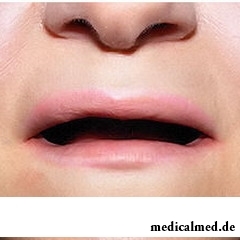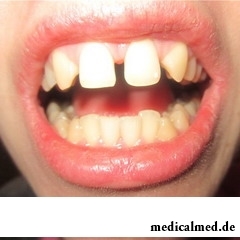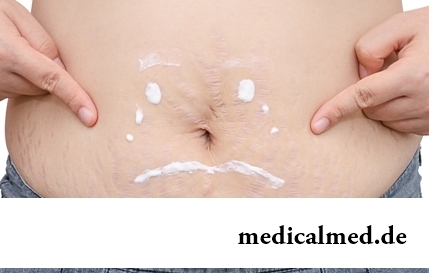





Edentia
What is an edentia? Types of an edentia
The edentia belongs to diseases of an oral cavity and means partial or total absence of teeth.
The edentia  depending on the reasons can be primary or secondary.
depending on the reasons can be primary or secondary.
Primary edentia has inborn character. Its reason is a lack of rudiments of teeth that is most often display of an angidrotichesky ectodermal dysplasia. Also symptoms of this disease are changes of skin (lack of hair, early aging of skin) and mucous membranes (pallor, dryness).
In some cases it is not possible to establish the reason of primary edentia. It is supposed that the rassasyvaniye of a rudiment of tooth can occur under the influence of a number of toxic influences or be a consequence of inflammatory process. Perhaps, the hereditary reasons and a number of endocrine pathologies play a role.
The secondary edentia meets more often. There is this edentia owing to partial or full loss of teeth or rudiments of teeth. The reasons there can be a set: most often it is injuries or a consequence of the started caries.
By the number of the absent teeth the edentia can be full or partial. The full edentia is a total absence of teeth. More often it is primary.
Clinic of an edentia
Depending on that, this edentia full or partial is, also the clinic is shown.
The full edentia leads to serious deformation of a facial skeleton. As a result there are disturbances of the speech: muffled pronunciation of sounds. The person cannot fully chew and bite off food. In turn there is a disturbance of food that leads to a number of diseases of digestive tract. Also full edentia leads to dysfunction of a temporal and mandibular joint. Against the background of a full edentia the mental status of the person is violated. The edentia at children leads to disturbance of their social adaptation and promotes development of mental disorders.
Primary full edentia at children is very rare and serious illness at which there are no rudiments of teeth. Disturbances of pre-natal development are the reason of this type of an edentia.
The clinic in the absence of timely treatment extremely heavy is also connected with the expressed changes in a facial skeleton.
Secondary full edentia is called loss of all teeth at their initial existence. More often the secondary full edentia arises owing to dental diseases: caries, a periodontal disease, and also after a surgical exodontia (at oncology, for example) or as an effect of injuries.
The secondary partial edentia has the same reasons, as primary. At a complication the stertost of solid tissues of teeth given to an edentia the hyperesthesia develops. At the beginning of process the soreness of the mouth at influence of chemical irritants appears. At the expressed process – pain at a smykaniye of teeth, influence of thermal, chemical irritants, mechanical influences.
Diagnosis
Diagnosis comes easy. There is enough clinic. Confirmation of some types of an edentia requires carrying out radiological inspection.
Treatment of an edentia
Primary full  edentia at children is treated by prosthetics which needs to be carried out, since 3-4 years of life. These children need dynamic observation of the specialist since the child has a great risk of a growth disorder of a jaw, as a result of prosthesis pressure.
edentia at children is treated by prosthetics which needs to be carried out, since 3-4 years of life. These children need dynamic observation of the specialist since the child has a great risk of a growth disorder of a jaw, as a result of prosthesis pressure.
At a secondary full edentia at adults prosthetics is performed using removable lamellar prostheses.
When using a method of fixed prosthetics at a full edentia it is necessary to carry out preliminary implantation of teeth.
Prosthetics complications:
- disturbance of normal fixing of a prosthesis because of an atrophy of jaws;
- allergic reactions to dentoprosthetic materials;
- development of inflammatory process;
- development of decubituses, etc.
Treatment of the secondary partial edentia complicated by a hyperesthesia includes a depulpation of teeth.
At treatment of secondary adentiya elimination of a causative factor, i.e. the disease or pathological process which led to an edentia is obligatory.
The American scientists made experiments on mice and came to a conclusion that water-melon juice prevents development of atherosclerosis of vessels. One group of mice drank usual water, and the second – water-melon juice. As a result vessels of the second group were free from cholesteric plaques.

Sooner or later hair turn gray at all. Many people try to hide these changes, returning natural color of the hair with the help about...
Section: Articles about health
The chia plant, or the Spanish sage, is from South America. The indigenous people of the continent since ancient times used its seeds in food: small, but very nutritious kernels, in a form the reminding fasolina. Indians knew about useful properties of seeds of a chia, and applied...
Section: Articles about health
Run - one of the most available and effective ways to revitalize the organism. Knowing about its extraordinary advantage, each of us at least once tried to make jogs, but only the few made these occupations regular. In spite of the fact that in jogging (easy jogging), apparently, there is nothing difficult, the beginning runners often make mistakes which lead to complete cessation of trainings. Let's consider 10 useful tips for beginners who will allow them to make regular п...
Section: Articles about health
Some people consider what for medicine of the 21st century of secrets in the field of health of the person almost does not exist. It absolutely not so. Than Bol...
Section: Articles about health
According to doctors, more than a half of men of 25-50 years suffer from frustration of the urinogenital sphere, but the minority sees a doctor from them. And in vain - even the insignificant discomfort in the field of generative organs can serve as a symptom of an illness fraught heavy посл...
Section: Articles about health
Among a set of the perfumery and cosmetic goods which are released today the special group is made by the means containing antibacterial components. Such types of gels, shampoos, soaps, creams, lotions and other products are positioned by manufacturers as a panacea from all diseases caused by pathogenic microorganisms. The unlimited and uncontrolled use of similar means becomes result of trustfulness of the buyers hypnotized by persuasive advertizing sometimes. Many spetsial...
Section: Articles about health
Bathing in broths of medical flowers and plants (phytobathtub) was eurysynusic since Cleopatra who is a good judge of everything...
Section: Articles about health
Tea is loved and use almost everything. This drink has tonic properties, contains the tannins capable to suppress activity of causative organisms. Recently great popularity was gained by teas with vegetable additives. Лечеб...
Section: Articles about health
Ability of an organism to resist to adverse environmental factors (to impact of temperature drops, humidity and pressure, to the attacks of causative organisms, etc.) directly depends on what the person eats. Business here not only in that cells of a body received a necessary set of nutrients, vitamins and microelements. Scientists established that such components which are capable to influence negatively immune system, in connection with also are a part of foodstuff...
Section: Articles about health
For the last decades the diabetes mellitus of the second type became really world problem. Number of cases annually cart...
Section: Articles about health
For many women the word "fat" sounds as a sentence. In aspiration to an ideal figure they try to exclude, first of all, from the menu all dishes containing fats without having at the same time a clear idea of a role of these substances in exchange processes, and about an afterbirth...
Section: Articles about health
The name of this disease precisely reflects the problem reason: it consists in the bra fastener pressure upon a certain zone of a back. At the same time one of vertebrae of chest department of a backbone is as if blocked and loses mobility, and the loading falling on it is distributed on the next vertebrae. At 70-80% of women local pains in a backbone point on which the fastener of the often put most on bra presses result....
Section: Articles about health
It is known that the person for 80% consists of water which participates in all processes of an organism. The person loses liquid daily – in...
Section: Articles about health
Helminthosis is one of the most widespread diseases. Statistically, any species of helminths infected every third inhabitant of the planet. Most of specialists even consider these data strongly underestimated: some uninvited "cohabitants" of N...
Section: Articles about health
Smoking not only exerts a negative impact on the state of health of the consumer of tobacco products, but is an air polluter the substances potentially dangerous to people around. In recent years significantly the number of the people aiming to get rid of an addiction increased. Business this difficult: having left off smoking, the person immediately begins to suffer from abstinence. Besides, many yesterday's smokers feel at first great disappointment as улучш...
Section: Articles about health
Contrary to popular belief, the multiple sclerosis (MS) is not connected neither with sclerous changes of walls of vessels, nor about age...
Section: Articles about health
About influence of fasting days on an organism it is told much – both about advantages, and about shortcomings. It is considered that fasting day in the form of a short-term monodiet is useful, promoting effective removal of slags from an organism whereas irregular, it is excessive п...
Section: Articles about health
Practice of use of table salt in the therapeutic purposes contains not one century. Applications which do by means of the fabric impregnated with saline solution are considered especially effective. They have antibacterial and antiinflammatory effect, help to heal wounds, exempt fabrics from excess liquid. Hypertonic salt solution of potassium chloride is applied outwardly at many morbid conditions. Let's tell about the most known of them....
Section: Articles about health
Cystitis, or inflammation of a mucous membrane of a bladder, this very widespread disease, which, owing to some persons...
Section: Articles about health
For many spouses the question of planning of a family is one of the main. The problem of the choice of effective and safe contraceptives at the same time comes out on top. Russians still not often resort to operation of a vasectomy extremely popular in the USA...
Section: Articles about health
Striya (extension) are the defects of skin having an appearance of direct or wavy strips from 1 to 10 cm long and 1-5 mm wide. In most cases at women of a striya are located on a stomach, hips, a breast or buttocks. At athletes they can appear on shoulders and the internal surface of forearms. At initial stages of development of an extension have red or lilac color, but over time their coloring turns pale, and strips become whitish, getting a nacreous shade....
Section: Articles about health
Sometimes it seems that modern society was divided into two camps: representatives of the first are sure that has to for contraception отвеч...
Section: Articles about health
The unpleasant feelings connected with spring breakdown are familiar almost to each of us. Often happens that in March-April on the person weakness leans: he suffers from drowsiness, complains of bad mood, loss of interest in life and failures in affairs....
Section: Articles about health
Many of us, probably, noticed more than once that from intellectual loadings at some point the brain as though "overheats" and "assimilation" of information is strongly slowed down. Especially this problem urgent for persons of age becomes more senior than fifty years. "Already badly I think", "the head will burst now", "memory as if is disconnected" - here that wants to be told at the time of information overload....
Section: Articles about health
The modern person not always manages to find housing in the environmentally friendly region and such work which would not do harm здо...
Section: Articles about health
Tuberculosis – a serious infectious disease which development is caused by mycobacteria (Koch's bacilli). The illness is known from an extreme antiquity. Long time fight against it was considered as ineffective. Quite often the disease affected the whole families, and mortality from it was very much...
Section: Articles about health
Aging — natural and inevitable process. Over time our skin loses elasticity, on it saggings are formed, the face form loses former clearness. The procedure of nitevy lifting (nitevy tightening) can successfully solve this problem. In order that it is better to get acquainted with this popular procedure, we will tell you 6 cognitive facts about it....
Section: Articles about health
